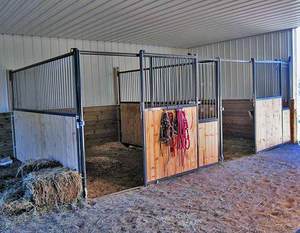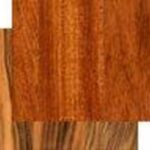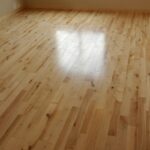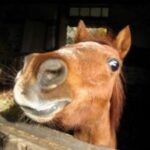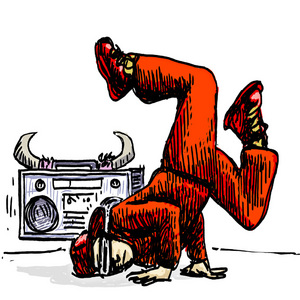The construction of horse stalls entails more than slapping together some scrap lumber and rigging a door. The size, strength, and behaviors of the horses themselves must be carefully considered in order to build safe and sound box stalls for horses. A horse kept in a box stall may want to walk around, lie down, kick, strike, bite, chew, or exhibit stress-related behaviors such as cribbing or weaving. These behaviors will influence decisions regarding horse stall size, building materials, flooring, lighting, and feed and water delivery.
Box Stall Size
Box stalls for average sized adult horses should measure no smaller than 10′ X 12′. Very large (warmblood or draft) or active horses or those who spend almost all of their time stalled should have larger stalls, as should stallions and mares with foals. Ponies and other small equines may need less roomy box stalls.
Horse Stall Materials
Horse stalls can be constructed from wood, metal (steel, iron, aluminum), concrete block, brick, or any combination thereof. Wood is the most traditional horse stall material but is also the most costly in terms of maintenance and likelihood to require repair and replacement. Many horses love to chew wood, and wood box stalls are an open invitation to destruction. However, wood is also the safest choice for a horse who kicks or strikes, as wood does provide a bit of “give” that helps reduce injuries to the joints of kickers. Metal, block, or brick stand up better to horse damage and are easier to maintain overall.
Stall Flooring
Horse stall flooring should provide good drainage (or adequate bedding should be supplied) and shock absorption to minimize leg strain in the horse. Concrete flooring is not advisable for these reasons. The stall floor should be kept level both to further minimize leg strain and to prevent the horse from becoming cast (stuck) when lying down and unable to rise. Sand or soil floors are often high maintenance as horses may dig and create holes and unevenness, requiring frequent filling and releveling. Heavy rubber stall mats, properly bedded, provide excellent shock absorption, a level surface, and moisture control.
Lighting
Natural lighting can be provided in a horse stall through skylights, sidelights, windows, or a Dutch door. Windows should be high and grated to prevent the horse from kicking, striking, or otherwise breaking the window. Dutch doors, while greatly enjoyed by most horses, are easily damaged by chewing and constant leaning. They also will promote draftiness in the box stall, even when closed. To minimize the possibility of the horse attempting to jump the Dutch door, the bottom half should be no less than 4′ tall.
Electrical lighting can also be provided in horse stalls, though it should be mounted high enough to prevent the horse from reaching it. Incandescent light bulbs should be protected from barn dust with a heavy glass globe. Metal cages around bulbs will provide added protection from horse damage. Wiring should be contained in rodent-proof conduit.
Providing Feed and Water
Grain and water buckets in box stalls should be mounted with the tops of the buckets no lower than 3′ off the ground using quick-release mechanisms in case a horse’s hoof or halter should become stuck in one. Hay mangers, if used, should be constructed and mounted in a manner to minimize the chance of a horse getting stuck if the horse should kick, strike, become cast, or panic in the stall.
Horse stall construction
Horse stalls should be constructed with no gaps larger than 2″ between any construction materials to prevent hooves from becoming caught. Dividing walls between box stalls should be at least 7′ tall – even taller and solid if horses in adjoining stalls are likely to fight. Exterior walls should be at least 8′ tall. All wood used in horse stall construction should be 2″ dimension lumber with any exposed wood edges covered with metal U-channel to reduce chewing.
Interior box stall doors should be 3 1/2-4′ wide and slide fully open. Avoid swinging doors for interior installations. Dutch or half doors are also not advisable as interior stall doors because of the probability of horses reaching into the barn to grab items, people, or other horses. No door latches or hardware other than bucket hooks should be present inside horse stalls.
In order to provide a safe indoor living environment for horses, box stalls must be at least as strong as the animals kept in them, and their construction must minimize the opportunity for injury. Keep these critical points in mind when building for your horse.
